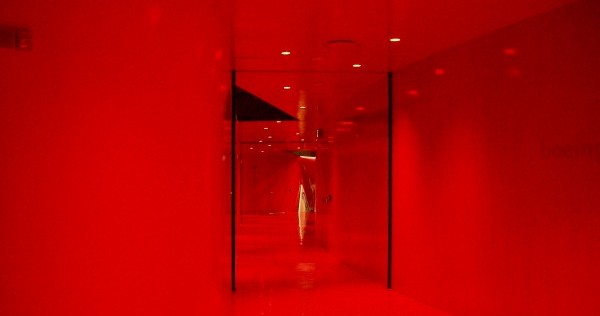
We humans cherish the color red. We admire autumn colors. We prize the red bracts of poinsettias. Santa Claus wears a red suit. Ancient peoples painted their bodies red with iron oxide, and Revlon provides rouge for this continuing purpose.
And red is angry, too. “It makes me see red!” The bullfighter’s cape infuriates the bull. Red is hot, intense, erotic. In Seattle, our new Rem Koolhaas library has a Red Room. There you experience red and only red—red stairs, red floor, red walls, red ceiling, red doors. To be precise, there you experience Benjamin Moore Vermillion, Rhumba Orange, Orange, Neon Red, Scarlet, Red Door, and yes, Hot Lips.
But red is purely a mental construct. It exists only in our minds.
A light source—say the sun—sends out electromagnetic waves of various lengths. Red is a long slow wave (it has length and frequency). Think of those long slow ocean waves. Light waves look white until separated by a prism such as a water drop. Red objects absorb the short light waves and reflect the long ones back to our eyeballs.
Then what? Light waves enter the cornea and go through the lens, bending before they hit the retina, that thin sheet of neurons at the back of the eyeball.
Now, a neuron can fire (emit an electrical pulse) or not fire. It can fire weakly or strongly. And it can fire in unison with other neurons. That’s all a neuron can do. Our brain has 100 billion of these neurons, each one firing or not firing. Neurons work in assemblies that shift and change.
The retina has five kinds of neurons, including photoreceptors—the cones and rods. We have six million cones (located at the center of the retina) and 120 million rods (located at the outer edges and contributing to night and peripheral vision). Cones are for color.
When a long light wave hits a red cone, the red cone fires. It projects (sends its pulse) to the next layer of retinal neurons, the ganglion cells. (Other neurons are stimulated to fire by edges, contrasts, motion, shape, form.)
Ganglion cells have long axons (stringlike appendages bundled as the optic nerve) that transmit these pulses back to the lateral geniculate nucleus, a structure in the thalamus. (In neuroscientific lingo a “nucleus” is a batch of related neurons.) The lateral geniculate nucleus resends the pulses farther back to the visual cortex. Up to and including arrival at the visual cortex, the pulses are transmitted distinctly and separately, as if they were streaming points on a map. Indeed, the brain is mapping the visual field.
Now, the neurons in the visual cortex project the pulses forward in two streams, one upper (the “where” stream) and one lower (the “what” stream).
Bingo! We see red. But how these light waves and electrical pulses resolve into the Rem Koolhaas Red Room—that is the mystery of subjective experience.
Read “Seeing Red” from our Spring 2011 issue

